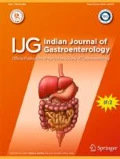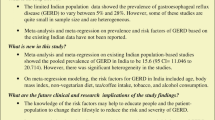Abstract
Background and Aim
Gastroesophageal reflux disease (GERD) is common worldwide with significant expenditure for health care. Community-based data on the prevalence of GERD in India remains scarce. This study was conducted to determine the prevalence of GERD and to identify potential associations.
Methods
A community-based survey of adults (aged ≥18 years) was done through population proportionate to size sampling in urban and rural areas of Vellore district, Tamil Nadu, India. GERD was defined as heartburn and regurgitation occurring at least twice per week. Associations between GERD and gender, age, anthropometric measures, and consumption of tobacco, alcohol, meat, and milk were evaluated. Odds ratios (OR) with 95% confidence intervals were derived from logistic regression models.
Results
Of 6174 participants (3157 urban, 2599 male), 8.2% had GERD. The prevalence was higher in urban (11.1%) compared to rural areas (5.1%) (p < 0.001). Among patients with GERD, 34.3% used medications daily for symptom relief. On univariate analysis, GERD was associated with female gender, living in an urban area, age >30, BMI >25, and infrequent milk consumption. On multivariate analysis, female gender (OR 1.3; 95% CI 1.1–1.6), living in urban area (OR 2.3; 95% CI 1.9–2.8), age >30 years (OR 1.9; 95% CI 1.4–2.5), BMI ≥ 25 kg/m2 (OR 1.3; 95% CI 1.1–1.6), and infrequent milk intake (OR 1.6; 95% CI 1.3–1.9) were independently associated with GERD.
Conclusion
Symptomatic GERD was found in 8.2% of respondents in this representative southern Indian community, being more prevalent in urban residents, women, older, and obese individuals.
Similar content being viewed by others
References
Vakil N, van Zanten SV, Kahrilas P, Dent J, Jones R, Global Consensus Group. The Montreal definition and classification of gastroesophageal reflux disease: a global evidence-based consensus. Am J Gastroenterol 2006;101:1900–920; quiz 1943.
Estores DS. Symptom predictability in gastroesophageal reflux disease and role of proton pump inhibitor test. Gastroenterol Clin N Am. 2014;43:27–38.
Gisbert JP, Cooper A, Karagiannis D, et al. Impact of gastroesophageal reflux disease on patients’ daily lives: a European observational study in the primary care setting. Health Qual Life Outcomes. 2009;7:60.
Wahlqvist P, Reilly MC, Barkun A. Systematic review: the impact of gastro-oesophageal reflux disease on work productivity. Aliment Pharmacol Ther. 2006 Jul 15;24:259–72.
Goh KL. Changing epidemiology of gastroesophageal reflux disease in the Asian-Pacific region: an overview. J Gastroenterol Hepatol. 2004;19 Suppl 3:S22–5.
Bhatia SJ, Reddy DN, Ghoshal UC, et al. Epidemiology and symptom profile of gastroesophageal reflux in the Indian population: report of the Indian Society of Gastroenterology Task Force. Indian J Gastroenterol. 2011;30:118–27.
Bhalaghuru CM, Vijaya S, Jayanthi V. Symptomatic gastroesophageal reflux amongst hospital personnel in South India. Indian J Med Sci. 2011;65:355–9.
IND_India.pdf [Internet]. [cited 2014 Apr 13]. Available from: http://censusindia.gov.in/2011census/censusinfodashboard/stock/profiles/en/IND_India.pdf. Accessed 10 Jan 2019
Ramakrishna BS, Makharia GK, Chetri K, et al. Prevalence of adult celiac disease in India: regional variations and associations. Am J Gastroenterol. 2016;111:115–23.
Dent J, Kahrilas PJ, Vakil N, et al. Clinical trial design in adult reflux disease: a methodological workshop. Aliment Pharmacol Ther. 2008;28:107–26.
Kumar N, Shekhar C, Kumar P, Kundu AS. Kuppuswamy’s socioeconomic status scale-updating for 2007. Indian J Pediatr. 2007;74:1131–2.
An evidence-based appraisal of reflux disease management--the Genval Workshop Report. Gut. 1999;44 Suppl 2:S1–16.
WHO Expert Consultation. Appropriate body-mass index for Asian populations and its implications for policy and intervention strategies. Lancet. 2004;363:157–63.
Alberti KG, Zimmet P, Shaw J. Metabolic syndrome--a new world-wide definition. A consensus statement from the International Diabetes Federation. Diabet Med J Br Diabet Assoc. 2006;23:469–80.
He J, Ma X, Zhao Y, et al. A population-based survey of the epidemiology of symptom-defined gastroesophageal reflux disease: the systematic investigation of gastrointestinal diseases in China. BMC Gastroenterol. 2010;10:94.
El-Serag HB, Sweet S, Winchester CC, Dent J. Update on the epidemiology of gastro-oesophageal reflux disease: a systematic review. Gut. 2014;63:871–80.
Wang H-Y, Leena KB, Plymoth A, et al. Prevalence of gastro-esophageal reflux disease and its risk factors in a community-based population in southern India. BMC Gastroenterol. 2016;16:36.
Kumar S, Sharma S, Norboo T, et al. Population based study to assess prevalence and risk factors of gastroesophageal reflux disease in a high altitude area. Indian J Gastroenterol. 2011;30:135–43.
Sharma A, Sharma PK, Puri P. Prevalence and the risk factors of gastro-esophageal reflux disease in medical students. Med J Armed Forces India. 2018;74:250–4.
Sharma PK, Ahuja V, Madan K, Gupta S, Raizada A, Sharma MP. Prevalence, severity, and risk factors of symptomatic gastroesophageal reflux disease among employees of a large hospital in northern India. Indian J Gastroenterol. 2011;30:128–34.
Shaha M, Perveen I, Alamgir MJ, Masud MH, Rahman MH. Prevalence and risk factors for gastro-esophageal reflux disease in the north-eastern part of Bangladesh. Bangladesh Med Res Counc Bull. 2012;38:108–13.
Li Y-M, Du J, Zhang H, Yu C-H. Epidemiological investigation in outpatients with symptomatic gastroesophageal reflux from the Department of Medicine in Zhejiang Province, east China. J Gastroenterol Hepatol. 2008;23:283–9.
Yamagishi H, Koike T, Ohara S, et al. Prevalence of gastroesophageal reflux symptoms in a large unselected general population in Japan. World J Gastroenterol. 2008;14:1358–64.
Moraes-Filho JP, Chinzon D, Eisig JN, Hashimoto CL, Zaterka S. Prevalence of heartburn and gastroesophageal reflux disease in the urban Brazilian population. Arq Gastroenterol. 2005;42:122–7.
Almadi MA, Almousa MA, Althwainy AF, et al. Prevalence of symptoms of gastroesopahgeal reflux in a cohort of Saudi Arabians: a study of 1265 subjects. Saudi J Gastroenterol. 2014;20:248–54.
Cossentino MJ, Wong RKH. Barrett’s esophagus and risk of esophageal adenocarcinoma. Semin Gastrointest Dis. 2003;14:128–35.
Kim K-M, Cho YK, Bae SJ, et al. Prevalence of gastroesophageal reflux disease in Korea and associated health-care utilization: a national population-based study. J Gastroenterol Hepatol. 2012;27:741–5.
Fujiwara Y, Higuchi K, Watanabe Y, et al. Prevalence of gastroesophageal reflux disease and gastroesophageal reflux disease symptoms in Japan. J Gastroenterol Hepatol. 2005;20:26–9.
Kalra S, Unnikrishnan A. Obesity in India: the weight of the nation. J Med Nutr Nutraceuticals. 2012;1:37.
Han TS, Sattar N, Lean M. ABC of obesity. Assessment of obesity and its clinical implications. BMJ. 2006;333:695–8.
Chang P, Friedenberg F. Obesity and GERD. Gastroenterol Clin N Am. 2014;43:161–73.
Sethi S, Richter JE. Diet and gastroesophageal reflux disease: role in pathogenesis and management. Curr Opin Gastroenterol. 2017;33:107–11.
Nocon M, Labenz J, Willich SN. Lifestyle factors and symptoms of gastro-oesophageal reflux -- a population-based study. Aliment Pharmacol Ther. 2006;23:169–74.
Zheng Z, Nordenstedt H, Pedersen NL, Lagergren J, Ye W. Lifestyle factors and risk for symptomatic gastroesophageal reflux in monozygotic twins. Gastroenterology. 2007;132:87–95.
Nilsson M, Johnsen R, Ye W, Hveem K, Lagergren J. Lifestyle related risk factors in the aetiology of gastro-oesophageal reflux. Gut. 2004;53:1730–5.
Cela L, Kraja B, Hoti K, et al. Lifestyle characteristics and gastroesophageal reflux disease: a population-based study in Albania. Gastroenterol Res Pract. 2013;2013:936792.
Chen T, Lu M, Wang X, et al. Prevalence and risk factors of gastroesophageal reflux symptoms in a Chinese retiree cohort. BMC Gastroenterol. 2012;12:161.
Dong Y, Peng C-YJ. Principled missing data methods for researchers. Springerplus. 2013;2:222.
Bennett DA. How can I deal with missing data in my study? Aust N Z J Public Health. 2001;25:464–9.
Author information
Authors and Affiliations
Corresponding author
Ethics declarations
Conflict of interest
SDC, GG, KR, BR, SP, JM, LJ, and BSR declare that they have no conflict of interest.
Ethical clearance
The authors declare that the study was performed in a manner conforming to the Helsinki declaration of 1975, as revised in 2000 and 2008 concerning human and animal rights, and the authors followed the policy concerning informed consent as shown on Springer.com. The study was approved by the Institutional Review Board of the Christian Medical College, Vellore.
Informed consent
All participants provided written informed consent.
Disclaimer
The authors are solely responsible for the data and the content of the paper. In no way, the Honorary Editor-in-Chief, Editorial Board Members, or the printer/publishers are responsible for the results/findings and content of this article.
Additional information
Publisher’s note
Springer Nature remains neutral with regard to jurisdictional claims in published maps and institutional affiliations.
Rights and permissions
About this article
Cite this article
Chowdhury, S.D., George, G., Ramakrishna, K. et al. Prevalence and factors associated with gastroesophageal reflux disease in southern India: A community-based study. Indian J Gastroenterol 38, 77–82 (2019). https://doi.org/10.1007/s12664-018-00931-6
Received:
Accepted:
Published:
Issue Date:
DOI: https://doi.org/10.1007/s12664-018-00931-6




